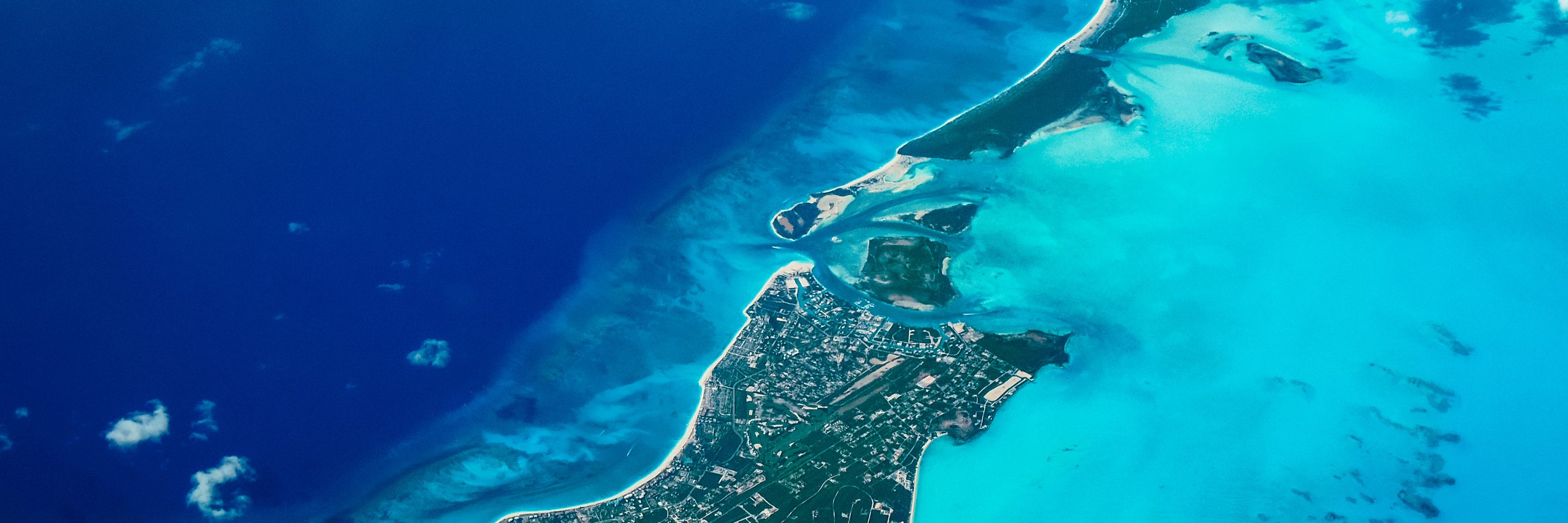
About Turks and Caicos
Turks and Caicos Islands
The Turks and Caicos Islands ("TCI") is a British Overseas Territory comprising 40 islands and cays, eight of which are inhabited. The eight inhabited islands are Providenciales, Grand Turk, Middle Caicos, South Caicos, North Caicos, Salt Cay, Pine Cay and Parrot Cay.
TCI is comprised of two island groups, the Caicos Islands to the west and the Turks Islands to the east, separated by a 27-mile wide deep-water channel.
TCI is located to the southeast of the Bahama island chain, and is separated from the Bahamas by a 30-mile wide ocean passage. The islands are located 575 miles southeast of Miami, approximately halfway between Miami and Puerto Rico.
The landmass of TCI covers 193 square miles and is surrounded by one of the largest coral reefs in the world. Including wetlands, TCI boasts 325 square miles of national parks, nature reserves, sanctuaries and historical sites, protected as part of TCI’s efforts to maintain the unspoiled beauty of its islands, and to preserve the indigenous flora and fauna.
Flying time from Miami to Providenciales is approximately one hour and thirty minutes. The geographical location of TCI makes it an ideal port of call for boats travelling between Florida and the Northern Leeward Islands.
TCI is on Eastern Standard Time (GMT –5) and daylight savings time is in effect from March through November.
'Beautiful by Nature'
Pristine, exquisite beaches and a very comfortable climate, an average annual temperature of 83 degrees and average rainfall of 22 inches annually, cooled by near constant trade winds, help to explain why the islands have become an increasingly popular tourist destination.
The official language of TCI is English, the only currency is the US Dollar and there are no exchange controls over the movement of funds into or out of the jurisdiction.
There is no direct taxation – no income tax, inheritance or estate tax, property tax, capital gains tax or corporate tax. The chief sources of government revenue are customs duty and stamp duty. Other indirect taxes include hotel room and restaurant food and beverage tax, departure tax, work permit fees and fees generated by the financial services industry.
The island of Grand Turk is TCI’s capital and seat of Government.
The population of TCI is estimated to be 49,000 in 2023 with the majority of residents living on the island of Providenciales which is the main business centre of TCI. Situated on the west side of the Caicos archipelago, Providenciales has an area of 38 square miles.
Tourism in TCI
Tourism is easily TCI’s most important industry with financial services a distant second.
In terms of direct contribution, tourism currently accounts for one-third of the country’s GDP, but when also taking into account the indirect and induced economic contributions known as the multiplier effect, tourism accounts for more than 85% of TCI’s GDP, perhaps significantly more. Unlike other tourism destinations in the world, the Caribbean region and TCI in particular experienced a strong recovery from the COVID pandemic. According to the United Nations World Tourism Organization (UNWTO), TCI was the best-performing global destination in 2023, with a post-pandemic return of tourism increasing visitor numbers by 127% (up to more than 1.5 million visitors).
In numeric terms this is largely driven by the return of cruise visitors to Grand Turk, and increased airlift and direct flight routes to Providenciales from North America and Canada, TCI’s leading source markets, and more recently, direct flight routes from London, UK opening up the growing European market. According to Google Flights, TCI has been the most searched destination by US residents looking for couples and family vacations and is also in the top five for solo travelers for summer 2024.
However, tourism is not necessarily a numbers game. An overnight visitor spends many times more than a cruise ship visitor. TCI’s major success in the tourism industry has been establishing itself as the top luxury destination in the Caribbean region. Its Key Performance Indicators (“KPI’s”) of Occupancy, Average Daily Rate (“ADR”) and Revenue Per Available Room (“REVPAR”) consistently places it at the top of the league table for tourism destinations in the region.
The world famous 14 mile long Grace Bay beach is the center of tourism development and consistently receives awards for being the best beach in the world.
With the increase in tourism and investment, the resident population of Providenciales has increased significantly over the last 40 years since its international airport first opened in the mid-1980s. The resident population of Providenciales increased fivefold from 1980 to 1990, tripled from 1990 to 2001 and has nearly tripled again through 2023.
Providenciales’ position as the economic centre of TCI is illustrated by the fact that nearly five times more people reside on Providenciales than on Grand Turk, the nation’s capital.
